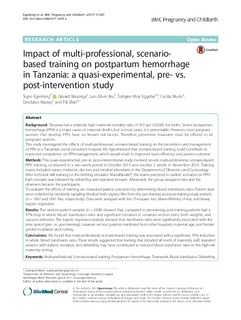| dc.description.abstract | Background
Tanzania has a relatively high maternal mortality ratio of 410 per 100,000 live births. Severe postpartum hemorrhage (PPH) is a major cause of maternal deaths, but in most cases, it is preventable. However, most pregnant women that develop PPH, have no known risk factors. Therefore, preventive measures must be offered to all pregnant women.
This study investigated the effects of multi-professional, scenario-based training on the prevention and management of PPH at a Tanzanian zonal consultant hospital. We hypothesized that scenario-based training could contribute to improved competence on PPH-management, which would result in improved team efficiency and patient outcome.
Methods
This quasi-experimental, pre-vs. post-interventional study involved on-site multi-professional, scenario-based PPH training, conducted in a two-week period in October 2013 and another 2 weeks in November 2014. Training teams included nurses, midwives, doctors, and medical attendants in the Department of Obstetrics and Gynecology. After technical skill training on the birthing simulator MamaNatalie®, the teams practiced in realistic scenarios on PPH. Each scenario was followed by debriefing and repeated scenario. Afterwards, the group swapped roles and the observers became the participants.
To evaluate the effects of training, we measured patient outcomes by determining blood transfusion rates. Patient data were collected by randomly sampling Medical birth registry files from the pre-training and post-training study periods (n = 1667 and 1641 files, respectively). Data were analyzed with the Chi-square test, Mann-Whitney U-test, and binary logistic regression.
Results
The random patient samples (n = 3308) showed that, compared to pre-training, post-training patients had a 47% drop in whole blood transfusion rates and significant increases in cesarean section rates, birth weights, and vacuum deliveries. The logistic regression analysis showed that transfusion rates were significantly associated with the time period (pre- vs. post-training), cesarean section, patients tranferred from other hospitals, maternal age, and female genital mutilation and cutting.
Conclusions
We found that multi-professional, scenario-based training was associated with a significant, 47% reduction in whole blood transfusion rates. These results suggested that training that included all levels of maternity staff, repeated sessions with realistic scenarios, and debriefing may have contributed to reduced blood transfusion rates in this high-risk maternity setting. | nb_NO |

